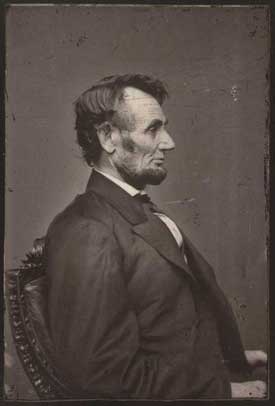Lincoln: Legend and Lore

Modern albumen print from 1864 wet-plate collodion negative /
National Portrait Gallery, Smithsonian Institution
Abraham Lincoln, as we view him today, is as much a product of legend as he is fact. Lincoln was a son of the early frontier and its storytelling tradition; much of the Lincoln lore was spun by Lincoln himself and perpetuated after his death by friends and colleagues. Such is the case of the most famous volume of stories about him, Lincoln’s Yarns and Stories by Colonel Alexander McClure.
A newspaperman and politician, McClure said, “Lincoln’s stories are like Lincoln himself. The more we know of them, the better we like them.” Lincoln joked about the politics, pretentious people, incompetent people, the law, the land, and himself. The stories that McClure records cannot all be directly attributed to Lincoln the man, but they are inextricably bound, thanks to McClure’s archive, to Lincoln the legend.
McClure tells of President Lincoln visiting the wounded troops from Chancellorsville at a Washington, D.C., hospital, and encountering an unusually tall private from a Pennsylvania volunteer regiment:
A whisper ran down the long row of cots that the President was in the building and would soon pass by. Instantly every boy in blue who was able arose, stood erect, hands to the side, ready to salute his Commander-in-Chief. The Pennsylvanian stood six feet seven inches in his stockings. Lincoln stood six feet four. As the President approached this giant towering above him, he stopped in amazement, and casting his eyes from head to foot and from foot to head, as if contemplating the immense distance from one extremity to the other, he stood for a moment, speechless. At length, extending his hand, he exclaimed, “Hello, comrade. Do you know when your feet get cold?”
Another story, this one embodying Lincoln’s self-effacing style, runs as follows:
The day following the adjournment of the Baltimore Convention, at which President Lincoln was renominated, various political organizations called to pay their respects to the President. While the Philadelphia delegation was being presented, the chairman of that body, in introducing one of the members, said, “Mr. President, this is Mr. S., of the second district of our State,—a most active and earnest friend of yours and the cause. He has, among other things, been good enough to paint and to present to our league rooms a most beautiful portrait of yourself.” President Lincoln took the gentleman’s hand in his, and shaking it cordially said, with a merry voice, “I presume, sire, in painting your beautiful portrait, you took your idea of me from my principles and not from my person.”
Many short comments are also attributed to Lincoln, fun certainly, but of questionable origin:
“What made the deepest impression upon you?” inquired a friend one day, “when you stood in the presence of the Falls of Niagara, the greatest of natural wonders?” “The thing that struck me most forcibly when I saw the Falls,” Lincoln responded, with characteristic deliberation, “was, where in the world did all that water come from?”
The complete text of Colonel McClure’s Lincoln’s Yarns and Stories can be found online at The Project Gutenberg Website. For more on Lincoln, visit the National Portrait Gallery’s exhibition “One Life: The Mask of Lincoln.”